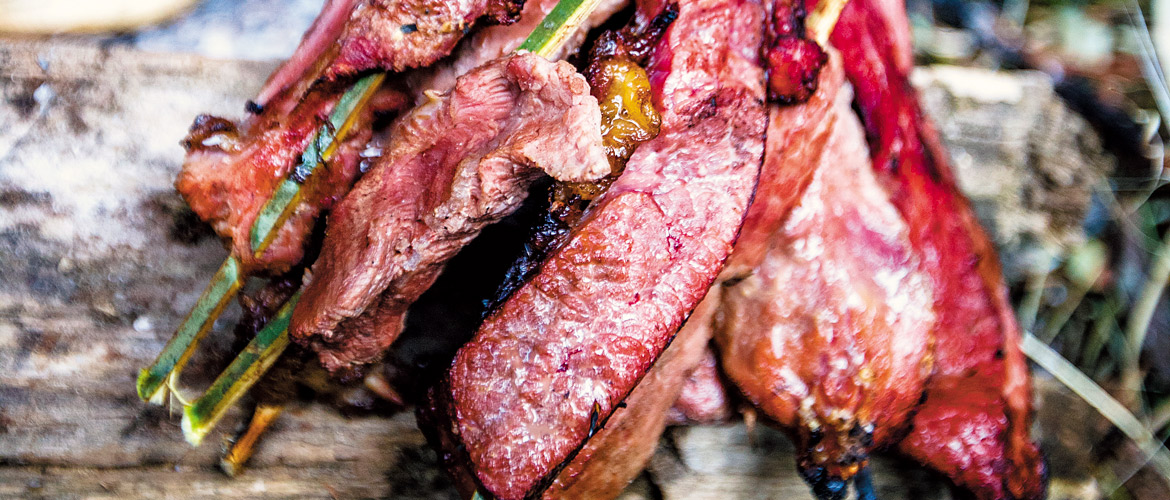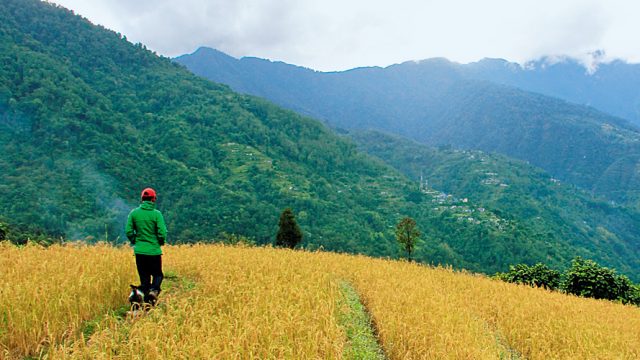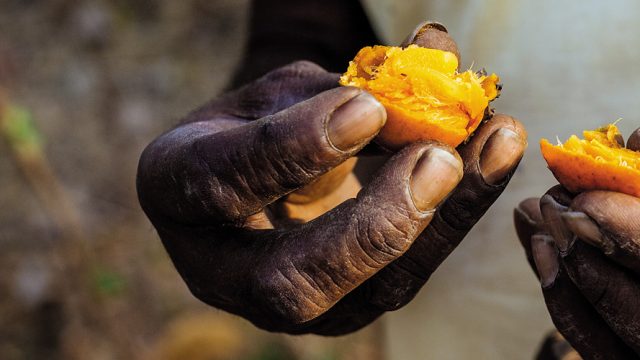Where else in India can you order a plate of porcupine? It was that time of the
At the table next to ours, the dude in a puffy blue Doraemon suit with an oversized head was getting leapt upon by diners under the happy influence. In a spontaneous free-for-all, some girls dived right into his mouth hole, to find his ‘real’ face and reason with it.

“Don’t take it personally—we’re kissing Doraemon, not you, so what’s the problem?” they cackled, presumably living out some dark childhood fantasies. They kept dragging him back by his white belly each time he tried to escape, so that he ended up moonwalking on the smooth bamboo flooring with padded paws, intensifying the already outrageous cartoon-world surrealism of the scene. This was too hilarious to be happening.
Doraemon’s job description at the Panyor River Festival at Yazali was absurd, and enviable: he was to appear randomly on stage during concerts and fashion shows, and break into free-style dance, hidden under the anonymity of his blue Manga cat suit. Then he’d play with kids, hang out at the bar, and generally socialise and circulate. And now he was getting smooched by pretty Arunachali Doraemon fans. He could very well be high through all this, and nobody would be able to tell.
At that moment, I knew what I wanted: I wanted to be Doraemon.
Soon we were all taking turns manhandling the hapless Doraemon, bouncing him about from corner to corner for cheap thrills, force-feeding him our boiled porcupine with bamboo shoot, erupting into near-transcendental hysterical glee, gagging on our own laughter and eventually blacking out, only to dissolve back into consciousness the following morning in a tent, still giggling uncontrollably.

Unable to keep a straight face, I thought I should share my Doraemon fantasies with my host, Mamma, a native of Yazali, and the subtle ringmaster behind the night. When he isn’t teaching at a college in Itanagar, Mamma organises this festival to promote tourism in this charming-but-swiftly-urbanising Nyishi tribal village in Arunachal Pradesh. Like many of my Arunachali friends, I had first met him at another such festival in Mechuka, near the Tibetan border, and we eventually became travel buddies.
“You know, I was Doraemon last year!” Mamma twinkled, triggering the next session of senseless laughter, and we launched into yet another round of gastronomic exploration with our newly forming epicurean-cum-alcoholic gang. Roasted meats, spicy chutneys, wild leafy greens, a trip to an orange orchard, late-night drunken volleyball scenes on a sandy riverbank after extended wine-tasting sessions, drives into the countryside…
I had found my tribe!

And so it went, on this Arunachal trip, which I still can’t get enough of… Wholesome organic food, endless humour, friendly uncomplicated people and happy villages set amid a backdrop of spectacular Himalayan landscapes, serendipity unfolding every day! What’s not to lerve?
Before I hit my stride as a solo traveller in these parts—and it did take a while—I must confess to having immersed myself in a festival-hopping phase. These ‘festivals’ are, by and large, organised events meant to bring in tourists from afar. But, apart from the odd traditional song or dance, they all mostly offer largely the same fare, the usual suspects being rafting, paragliding, zip-lining, weird Bollywood-style performances, VIP seating for politicians and, at times, cute-to-notorious levels of drunkenness by night-end.
Also, typically, they end up attracting mainly locals, who approach them as they would any other tribal festival—an occasion to dress up in traditional attire, eat, drink, socialise and make merry. Food is served to local taste, and so is the apong, a tradition here with every tribe, household and event. It’s perfectly normal to make conversation with just about anybody (there is no concept of ‘strangers’ in villages and small towns), and the apong certainly helps. As a result, these festivals are, at least for the time being, the immersive solo traveller’s dream come true, simply because they are so local and have failed to attract the number of ‘tourists’ they were meant to. Real travellers want to meet locals, not tourists—truly, a happy accident!
On my first trip, the food stalls at these festivals started out as a regular epicurean prowl, in a state that has very few ‘local’ restaurants, but soon became my chance backdoor entry into the social milieu.
At the Adventure Festival in Mechuka, a quaint little town nestled in a valley surrounded by a spectacular backdrop of snow-peaked mountains near the Indo-Tibetan border, the real adventure is to be found at the food stalls, a melting pot of tribal people, cultures and cuisines from the region. Forget about the ‘activities’.

To understand Arunachali food, it helps to know that, in a very broad sense, this sprawling state comprises three distinct cultures. The first set could include Galos, Apatanis, Nyishis and a diverse set of ‘sub-tribes,’ generically known as the ‘Adis’. All of these tribes are nature worshippers and have more similarities than differences. They believe in forest spirits, practise shamanic rituals and animal sacrifice, and believe in a common ancestry with Abo Tani, a mystical being they believe to be the father of all mankind
These Tani tribes, as they are also sometimes called, generally use a lot of fermented bamboo shoot in their cooking. This is something of an acquired taste, though I instantly loved the flavour. Tani food is either stewed, steamed in wild leaves or fire-roasted, and uses a lot of local chilli. Like most tribal food, this kind of cooking depends heavily on the freshness of ingredients, the availability of forest produce and the flavour of wood fire. Luckily, Arunachal is still 80 per cent forest, so all is well in paradise so far.

A second distinct group includes Indo-Tibetan Buddhist tribes such as the Monpas, Membas and Sherdukpen from near the Bhutanese and Tibetan border areas. These communities have characteristics of the Trans-Himalayan Tantric Buddhist culture, extending all the way from Tibet through northwestern Arunachal, Bhutan, Sikkim, Ladakh, and Lahaul and Spiti in Himachal Pradesh.
Their cuisine too has a lot of Tibetan influence. They eat varieties of pasta (like thenthuk, thukpa and momos), drink salty butter tea, use ghee and a strongly aromatic fermented cheese called ‘churpee’ in their stews. BecauseMechuka has a large Memba population, it’s a bit like a Hindi-speaking version of Tibet, both in terms of culture and landscape.
A third broad branch of tribes from Eastern Arunachal, like the Tai Khamtis and Tangsas, is more related culturally and gastronomically to Nagaland, Burma and Thailand. This is a cuisine I am yet to explore fully, but it is considered by many to be the best of all. Khamti sticky rice is so astonishingly delicious, it’s a dish all by itself. My favourite is khaolam—sticky rice filled in a bamboo hollow, slowly char-cooked on a fire and then pulled out to form a gooey rice tube, encased in a crisp skin by the bamboo’s inner membrane, and finally sliced into coin-shaped biscuits. Yum!

Apong is, fortunately, common to all the tribes.
Many smaller tribes, of course, do not fit into these general categories, such as the Idu Mishmis of Dibang Valley, easily one of the densest high-altitude jungles in the world. My introduction to homemade tribal food was the Idu asumbi—a starchy, cornmeal-based stew made either with meat or wild leaves, bamboo shoot, schezwan pepper and local chilli, at my friend Poonam Mihu’s place in Anini. This was simple comfort food, and just thinking about it makes me nostalgic.
I can’t recall the exact moment that I came up with the idea of a book documenting tribal cuisine in Arunachal Pradesh, but it so happened that one morning, I found myself chewing on crunchy beetles that a stranger had just handed me, trying to determine whether they tasted nutty. But it’s possible that this was when I concluded that I was already in the deep end of things, and so decided to go all the way.

For the record, the verdict did eventually swing to an odd kind of nutty. Gandipuk beetles, a delicacy in these parts, are found under rocks by the riverside, and their fans just can’t get enough of them—raw or toasted and crushed into a chutney with ginger, garlic, chillies and salt.
And, oh yes, on rare occasions they can also be psychotropic (probably the reason why their fans are so crazy about them), in a scary sort of way; something I was told about after having eaten them. There are plenty of stories going around about Gandipuk trippers who start believing that they’ve turned into beetles themselves, and then try and crawl under rocks for safety.
There was also something in the local papers about a bunch of Gandipuk freaks mobbing a bamboo hanging bridge, after having spotted a swarm flying over it, dropping the bridge with their collective weight and falling into the river together. Typical with Gandipuk tripper stories, the impression is split between funny and disastrous. Fortunately, none of the above happened in my case.
Lately, I’ve begun to look beyond the weird, freaky or exotic. In my travels, I score as many invitations as I can to lunches, dinners, parties, weddings, shamanic rituals and animist festivals. I don’t just eat; I also try to understand what’s going on. Food for the book has now become an excuse to keep returning to my favourite part of the country.
And yes, I get to be Doraemon next year!
cuisine
food
Sanjiv Valsan





